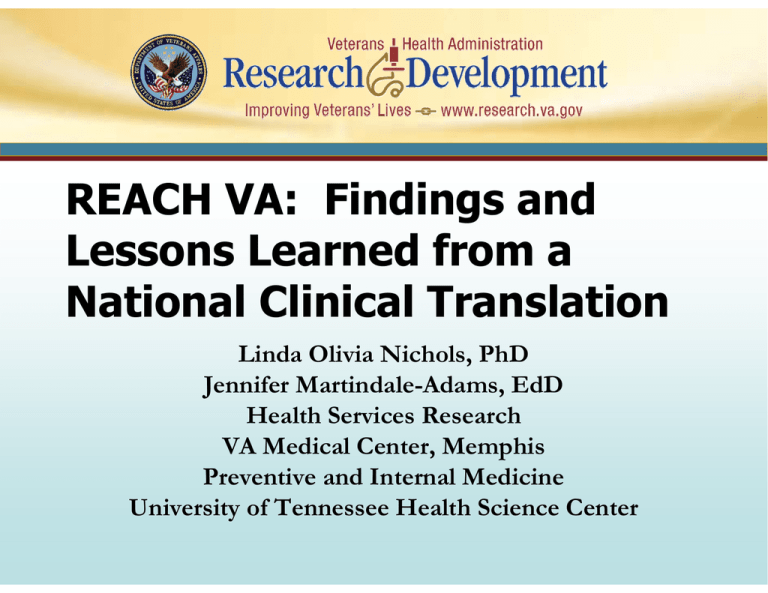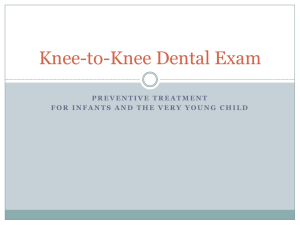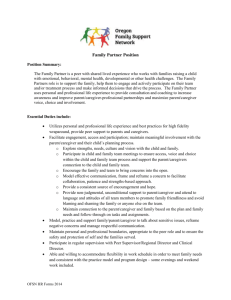REACH VA: Findings and Lessons Learned from a National Clinical Translation
advertisement

REACH VA: Findings and Lessons Learned from a National Clinical Translation Linda Olivia Nichols, PhD Jennifer Martindale-Adams, EdD Health Services Research VA Medical Center, Memphis Preventive and Internal Medicine University of Tennessee Health Science Center Resources for Enhancing Alzheimer's Caregivers Health (REACH II) • Multi-component 6 month, randomized clinical trial, 6/02 to 12/04 • Funded by NIA and NINR, additional support from VA • Five sites and Coordinating Center • Recruited 642 caregiver dyads o o o African Americans/Blacks Hispanics/Latinos Caucasians/Whites REACH II • • • • • • • • • • Structured and targeted Risk based Education Safety Emotional well being Self-care Social support Patient problem behaviors/caregiver skills Six month duration 12 individual sessions • • • Home and by telephone 5 telephone groups Computer assisted telephones Individually prepared behavior and stress/coping prescriptions (CG and CR) REACH II Findings • Improvement in quality of life (burden, patient management, depression, self-care, social support) for intervention caregivers, compared to control: o Hispanic/Latino (p < .001) o White/Caucasian (p = .037) o Black/African American spouses (p = .003) • Lower prevalence of clinical depression (p = .001) for intervention caregivers • One additional hour of non-caregiving time per day at a cost of $4.96 per day per caregiver Belle et al., Ann Int Med, 2006; Nichols et al., JAGS, 2008, REACH II implemented into VHA • Caregiver Assistance pilot program o o o Congressional funding to Veterans Health Administration VHA Patient Care Services funded Evidence based, promising clinical interventions • Home Based Primary Care o o Psychologist, Social Worker, or Nurse Added to normal duties REACH II • • • • • • • • • • Structured and targeted Risk based Education Safety Emotional well being Self-care Social support Patient problem behaviors/caregiver skills Six month duration 12 individual sessions o • Home and by telephone 5 telephone groups Computer assisted telephones Individually prepared behavior and stress/coping prescriptions (CG and CR) REACH VA • • • • • • • • • • Structured and targeted Risk based Education Safety Emotional well being Self-care Social support Patient problem behaviors/caregiver skills Six month duration 12 individual sessions o • Home and by telephone 5 telephone groups Regular telephones Caregiver workbook with prepared behavior and stress/coping topics REACH VA Sites •Connecticut •Colorado •California • Georgia • Michigan •Minnesota •New Mexico • New York •North Carolina •Ohio • Pennsylvania • Tennessee • Texas • Utah • West Virginia Coordinating Center - Memphis CC REACH VA Caregiver Findings • Intervention, compared to control, caregivers over six months, improvement in: Burden (p = .008) o Depression (p = .030) o Effect of depression on daily life (p = .031) o Troubling patient behaviors (p = .046) o Caregiver frustrations (abusive behaviors) (p = .012) • Two hours per day decrease in time on duty (p = .055) o • Cost of $2.93 per caregiver per day REACH VA Caregiver Satisfaction REACH VA Staff Satisfaction PARiHS Framework Elements • Evidence • Context • Facilitation Weak to strong support for implementation Promoting Action on Research Implementation in Health Services PARiHS Framework Element: Evidence Evidence Subelements REACH VA factors • • REACH II RCT findings Research • Clinical experience • Patient experience • Local knowledge • Home Based Primary Care psychologists, social workers, nurses, administrators Lessons Learned Evidence • Translation not duplication • See beyond research model • Adapt to your setting • Minimize amount of change • Actual translation needs to be done by someone steeped in the intervention PARiHS Framework Element: Context Context Subelements • • • Culture Leadership Evaluation REACH VA factors • Congress directed and funded • Patient Care Services, Office of Home and Community Care and Caregiver Support Program • Memphis VA Medical Center funded to develop, train, and evaluate Lessons Learned Context • All levels must buy in • Has to fit into the system • Fiscal responsibility - have to capture workload PARiHS Framework Element: Facilitation Facilitation Subelements REACH VA factors • Facilitation • Characteristics • Manuals, scripts, talking points • Role • Style • Live and online archived training • Technical assistance calls Lessons Learned Facilitation • Human interaction critically important • Coaching • User-friendly o o Just-in-time Customized • Meet people where they are • Role play/feedback/examples Research to Translation • From controlled research environment to larger health care system • All components in place for successful implementation • Outcome evaluation to determine if similar results • Formative evaluation necessary to identify challenges and hurdles • Continuous quality improvement to refine process Future Efforts and Directions • Caregiver legislation – VHA new directions • All HBPC sites planned • Additional VHA modalities (in facility, by telephone) • Additional VHA settings (Adult Day Health Care, Medical Foster Care) • Additional populations of VHA caregivers (TBI, SCI, PTSD, Polytrauma) • Other programs – AoA REACH interventions, Rosalynn Carter Institute, other community agencies • • • • • Robert Burns, MD Celeste Bursi, MSSW Marshall Graney, PhD Barbara Higgins, MA Sarah Kennedy, MA • Jennifer MartindaleAdams, EdD • Pat Miller, MA • Linda Nichols, PhD • Jeff Zuber, MA





